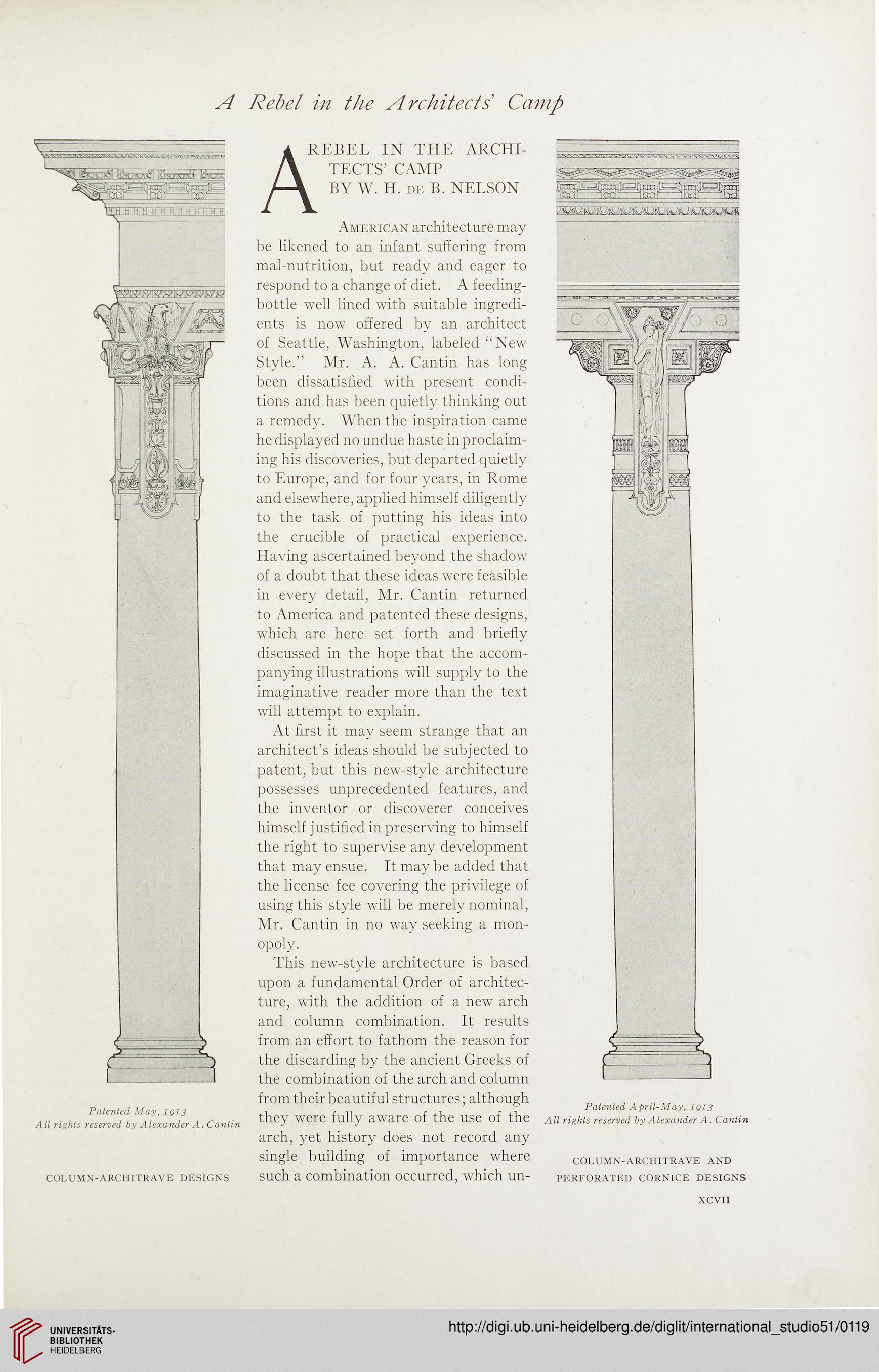A Rebel in the Architects Camp
Patented May, 1913
All rights reserved by Alexander A. Cantin
COLUMN-ARCHITRAVE DESIGNS
A REBEL IN THE ARCHI-
TECTS’ CAMP
BY W. H. de B. NELSON
American architecture may
be likened to an infant suffering from
mal-nutrition, but ready and eager to
respond to a change of diet. A feeding-
bottle well lined with suitable ingredi-
ents is now offered by an architect
of Seattle, Washington, labeled “New
Style.” Mr. A. A. Cantin has long
been dissatisfied with present condi-
tions and has been quietly thinking out
a remedy. When the inspiration came
he displayed no undue haste in proclaim-
ing his discoveries, but departed quietly
to Europe, and for four years, in Rome
and elsewhere, applied himself diligently
to the task of putting his ideas into
the crucible of practical experience.
Having ascertained beyond the shadow
of a doubt that these ideas were feasible
in every detail, Mr. Cantin returned
to America and patented these designs,
which are here set forth and briefly
discussed in the hope that the accom-
panying illustrations will supply to the
imaginative reader more than the text
will attempt to explain.
At first it may seem strange that an
architect’s ideas should be subjected to
patent, but this new-style architecture
possesses unprecedented features, and
the inventor or discoverer conceives
himself justified in preserving to himself
the right to supervise any development
that may ensue. It maybe added that
the license fee covering the privilege of
using this style will be merely nominal,
Mr. Cantin in no way seeking a mon-
opoly.
This new-style architecture is based
upon a fundamental Order of architec-
ture, with the addition of a new arch
and column combination. It results
from an effort to fathom the reason for
the discarding by the ancient Greeks of
the combination of the arch and column
from their beautiful structures; although
they were fully aware of the use of the
arch, yet history does not record any
single building of importance where
such a combination occurred, which un-
Patented April-May, 1913
All rights reserved by Alexander A. Cantin
COLUMN-ARCHITRAVE AND
PERFORATED CORNICE DESIGNS.
XCVII
Patented May, 1913
All rights reserved by Alexander A. Cantin
COLUMN-ARCHITRAVE DESIGNS
A REBEL IN THE ARCHI-
TECTS’ CAMP
BY W. H. de B. NELSON
American architecture may
be likened to an infant suffering from
mal-nutrition, but ready and eager to
respond to a change of diet. A feeding-
bottle well lined with suitable ingredi-
ents is now offered by an architect
of Seattle, Washington, labeled “New
Style.” Mr. A. A. Cantin has long
been dissatisfied with present condi-
tions and has been quietly thinking out
a remedy. When the inspiration came
he displayed no undue haste in proclaim-
ing his discoveries, but departed quietly
to Europe, and for four years, in Rome
and elsewhere, applied himself diligently
to the task of putting his ideas into
the crucible of practical experience.
Having ascertained beyond the shadow
of a doubt that these ideas were feasible
in every detail, Mr. Cantin returned
to America and patented these designs,
which are here set forth and briefly
discussed in the hope that the accom-
panying illustrations will supply to the
imaginative reader more than the text
will attempt to explain.
At first it may seem strange that an
architect’s ideas should be subjected to
patent, but this new-style architecture
possesses unprecedented features, and
the inventor or discoverer conceives
himself justified in preserving to himself
the right to supervise any development
that may ensue. It maybe added that
the license fee covering the privilege of
using this style will be merely nominal,
Mr. Cantin in no way seeking a mon-
opoly.
This new-style architecture is based
upon a fundamental Order of architec-
ture, with the addition of a new arch
and column combination. It results
from an effort to fathom the reason for
the discarding by the ancient Greeks of
the combination of the arch and column
from their beautiful structures; although
they were fully aware of the use of the
arch, yet history does not record any
single building of importance where
such a combination occurred, which un-
Patented April-May, 1913
All rights reserved by Alexander A. Cantin
COLUMN-ARCHITRAVE AND
PERFORATED CORNICE DESIGNS.
XCVII




